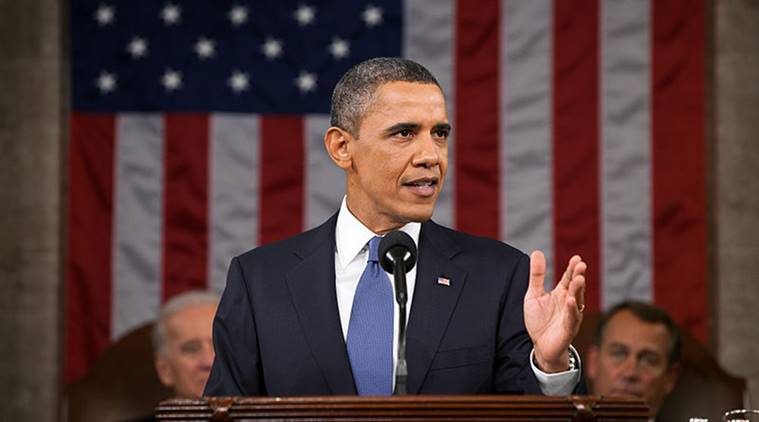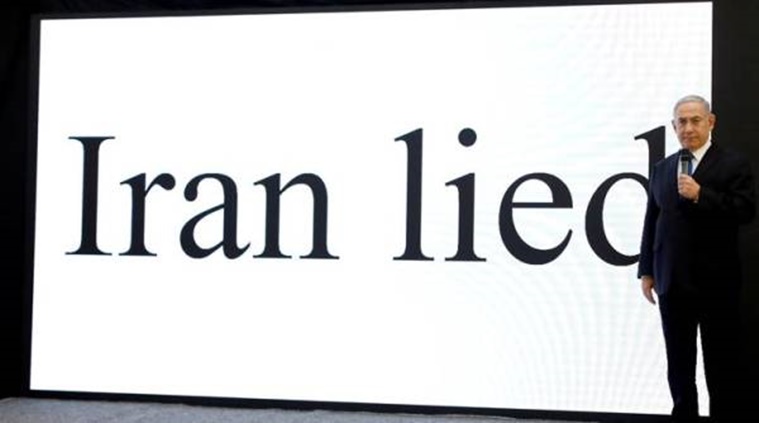What is the Iran nuclear Deal?
Under the 2015 nuclear deal struck by Iran and six major powers – Britain, China, France, Germany, Russia and the United States, Tehran agreed to limit its nuclear program in return for relief from U.S. and other economic sanctions.
 US President Donald Trump signs a proclamation declaring his intention to withdraw from the JCPOA Iran nuclear agreement in the Diplomatic Room at the White House in Washington, US, on May 8, 2018. (Source: Reuters)
US President Donald Trump signs a proclamation declaring his intention to withdraw from the JCPOA Iran nuclear agreement in the Diplomatic Room at the White House in Washington, US, on May 8, 2018. (Source: Reuters)
US President Donald Trump announced on May 8 that he will pull the United States out of the Iran nuclear deal, a 2015 agreement that capped over a decade of hostility between Tehran and the West over its atomic program. The Iran nuclear deal was signed between Iran and the P5 (the five permanent members of the UN Security Council) plus Germany and the European Union in Vienna in July 2015. Under the 2015 nuclear deal struck by Iran and six major powers – Britain, China, France, Germany, Russia and the United States, Tehran agreed to limit its nuclear program in return for relief from the US and other economic sanctions.
Here’s what Iran’s nuclear program terms were under the deal:
 Iran could only maintain a stockpile of 300 kilograms of low-enriched uranium, compared to the 100,000 kilograms of higher-enriched uranium it once had. It could enrich uranium to 3.67 percent, which can be used to fuel a reactor but was far below the 90 percent needed to produce a weapon. (Source: AP)
Iran could only maintain a stockpile of 300 kilograms of low-enriched uranium, compared to the 100,000 kilograms of higher-enriched uranium it once had. It could enrich uranium to 3.67 percent, which can be used to fuel a reactor but was far below the 90 percent needed to produce a weapon. (Source: AP)
The deal also limited the number of centrifuges Iran can run and restricted it to an older, slower model. Iran also reconfigured a heavy-water reactor so it couldn’t produce plutonium and agreed to convert its Fordo enrichment site into a research centre. It granted more access to International Atomic Energy Agency inspectors and allowed it to inspect other sites.
In exchange, world powers lifted the economic sanctions that had kept Iran away from international banking and the global oil trade. It allowed Iran to make purchases of commercial aircraft and reach other business deals. It also unfroze billions of dollars Iran had overseas.
 The deal, however, does not directly stop Iran from testing or firing ballistic missiles. It also has a series of rolling expiration dates. In 8 ½ years, for example, Iran can start testing up to 30 more advanced centrifuges, a number it can greatly expand two years later. (Source: AP)
The deal, however, does not directly stop Iran from testing or firing ballistic missiles. It also has a series of rolling expiration dates. In 8 ½ years, for example, Iran can start testing up to 30 more advanced centrifuges, a number it can greatly expand two years later. (Source: AP)
Fifteen years after the deal, restrictions on Iran’s uranium enrichment and stockpile size will end. The deal’s opponents argue it allows Iran to build a bomb after it expires, something Iran had explicitly promised in the accord not to do. In theory, Iran could have an array of advanced centrifuges ready for use, the limits on its stockpile would be gone, and it could then throw itself wholeheartedly into producing highly enriched uranium. But at the same time, nothing in the deal prevents the West from trying to rein Iran in again with sanctions.
 Former US president Barack Obama called Trump’s announcement a ‘serious mistake’ and said that the deal negotiated by his administration had worked in rolling back Iran’s nuclear programme. “I believe that the decision to put the JCPOA at risk without any Iranian violation of the deal is a serious mistake,” Obama said. (Source: AP File Photo)
Former US president Barack Obama called Trump’s announcement a ‘serious mistake’ and said that the deal negotiated by his administration had worked in rolling back Iran’s nuclear programme. “I believe that the decision to put the JCPOA at risk without any Iranian violation of the deal is a serious mistake,” Obama said. (Source: AP File Photo)
Here’s a timeline of major events over the timespan of the Iran nuclear deal:
 February 2006: Iran announces it will restart uranium enrichment following the election of hard-line President Mahmoud Ahmadinejad, a critical Iran report by the IAEA and after Britain, France and Germany walk out of stalled negotiations. (Source: AP)
February 2006: Iran announces it will restart uranium enrichment following the election of hard-line President Mahmoud Ahmadinejad, a critical Iran report by the IAEA and after Britain, France and Germany walk out of stalled negotiations. (Source: AP)
June 2006: The United States, Russia and China join Britain, France and Germany to form the P5+1 group of nations trying to persuade Iran to curb its nuclear program. Washington initially stays away from the negotiating table.
December 2006: The UN Security Council imposes the first set of sanctions on Iran, banning the sale of sensitive nuclear technology.
November 2007: The number of uranium-enriching centrifuges assembled by Iran reaches about 3,000 from just a few hundred in 2002. Its stockpile of low-enriched uranium also grows, giving Tehran the ability to, theoritically, make enough-weapons grade uranium for an atomic bomb.
 July 2008: Under former President George W. Bush, the United States joins the nuclear talks for the first time. (Source: AP)
July 2008: Under former President George W. Bush, the United States joins the nuclear talks for the first time. (Source: AP)
October 2009: Under President Barack Obama, a senior U.S. diplomat meets one-on-one with Iran’s top nuclear negotiator. The talks are some of the most extensive between Washington and Tehran in three decades. (Source: AP)
February 2010: Iran announces it has started to enrich uranium to near 20 percent, a technical step away from weapons-grade material.
 August 2013: Hassan Rouhani defeats several hard-line candidates to become Iran’s president, declaring his country ready for serious nuclear talks. By now, Iran has about 20,000 centrifuges and the U.S. estimates the country is only a few months away from nuclear weapons capability. (Iranian Presidency Office via AP)
August 2013: Hassan Rouhani defeats several hard-line candidates to become Iran’s president, declaring his country ready for serious nuclear talks. By now, Iran has about 20,000 centrifuges and the U.S. estimates the country is only a few months away from nuclear weapons capability. (Iranian Presidency Office via AP)
November 2013: Iran and the six powers announce an interim agreement that temporarily curbs Tehran’s nuclear program and unfreezes some Iranian assets. The deal sets the stage for extended negotiations on a comprehensive nuclear accord.
 July, 2015: World powers and Iran announce long-term, comprehensive nuclear agreement. (Source: AP)
July, 2015: World powers and Iran announce long-term, comprehensive nuclear agreement. (Source: AP)
October 2015: Iran conducts its first ballistic missile test since the nuclear deal. The US accuses Iran of violating a UN Security Council resolution, but former President Barack Obama acknowledges that ballistic missiles are “entirely separate” from the nuclear deal.
Jan. 16, 2016: The IAEA acknowledges Iran has met its commitments under the nuclear deal, which sees most sanctions on Iran lifted. It takes time but Iran re-enters the global banking system and begins selling crude oil and natural gas on the international market. Next day, the US imposes sanctions over Iran’s ballistic missile tests.
 April 2018: Israeli Prime Minister Benjamin Netanyahu revealed on April 30,2018, what he said was evidence of a secret Iranian nuclear weapons program that could step up pressure on the United States to pull out of a 2015 nuclear deal with Iran. (Source: Reuters)
April 2018: Israeli Prime Minister Benjamin Netanyahu revealed on April 30,2018, what he said was evidence of a secret Iranian nuclear weapons program that could step up pressure on the United States to pull out of a 2015 nuclear deal with Iran. (Source: Reuters)
October 2018: Trump announces he will not re-certify the Iran nuclear deal as required, criticizing the accord by saying it “threw Iran’s dictatorship a political and economic lifeline.”
 U.S. President Donald Trump holds up a proclamation declaring his intention to withdraw from the JCPOA Iran nuclear agreement after signing it in the Diplomatic Room at the White House in Washington, U.S. May 8, 2018. (Source: reuters)
U.S. President Donald Trump holds up a proclamation declaring his intention to withdraw from the JCPOA Iran nuclear agreement after signing it in the Diplomatic Room at the White House in Washington, U.S. May 8, 2018. (Source: reuters)
- 01
- 02
- 03
- 04
- 05































